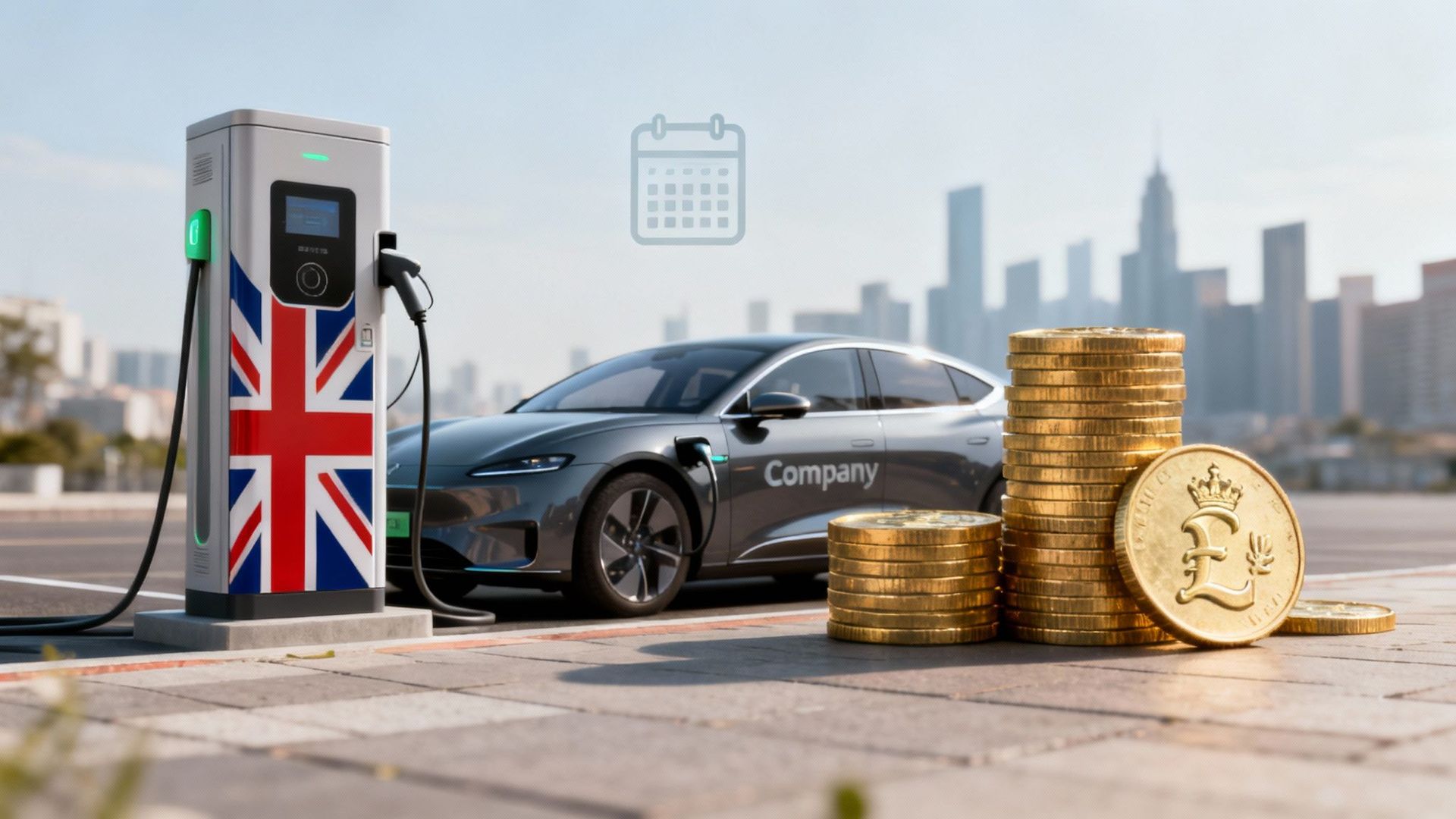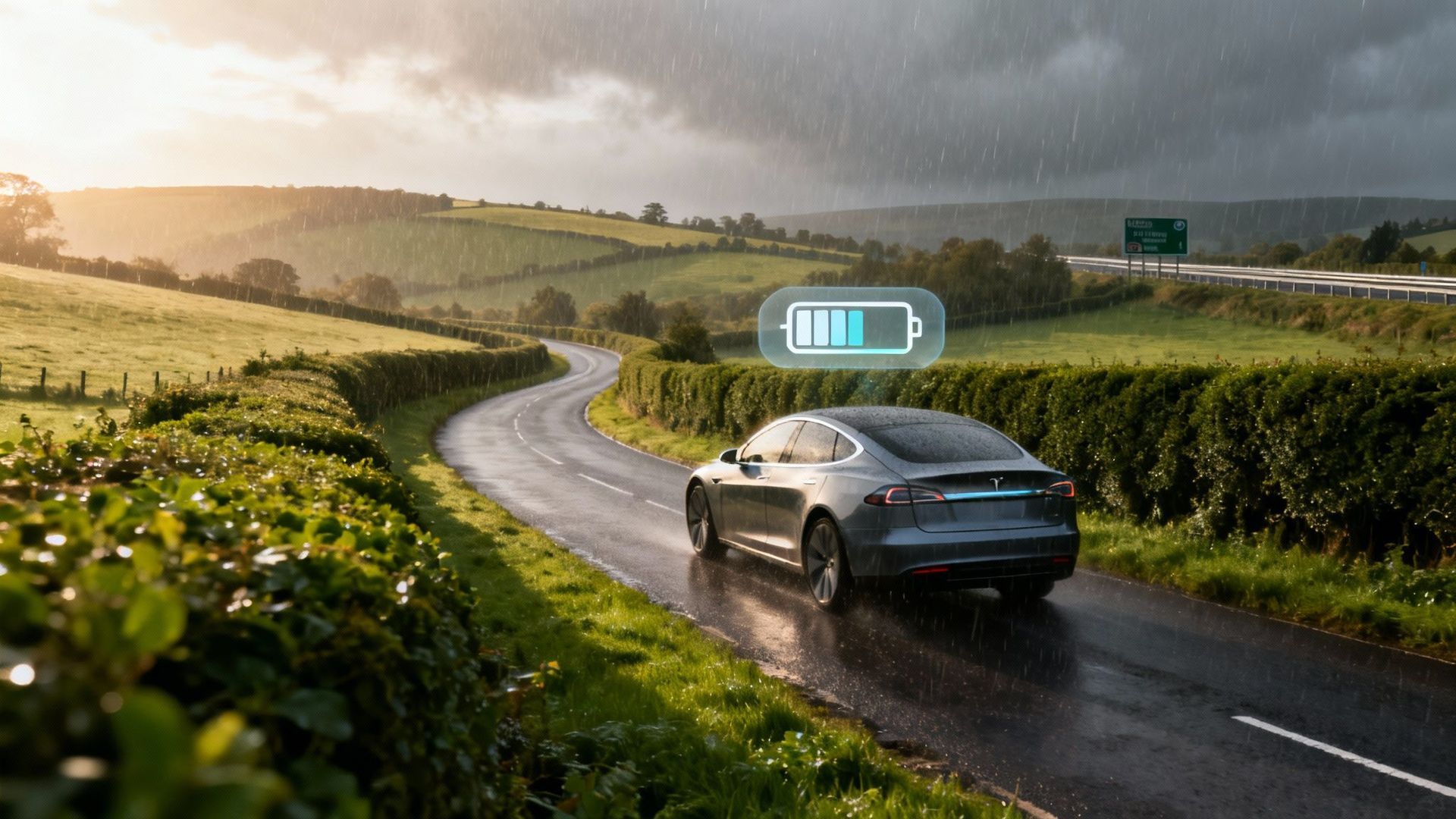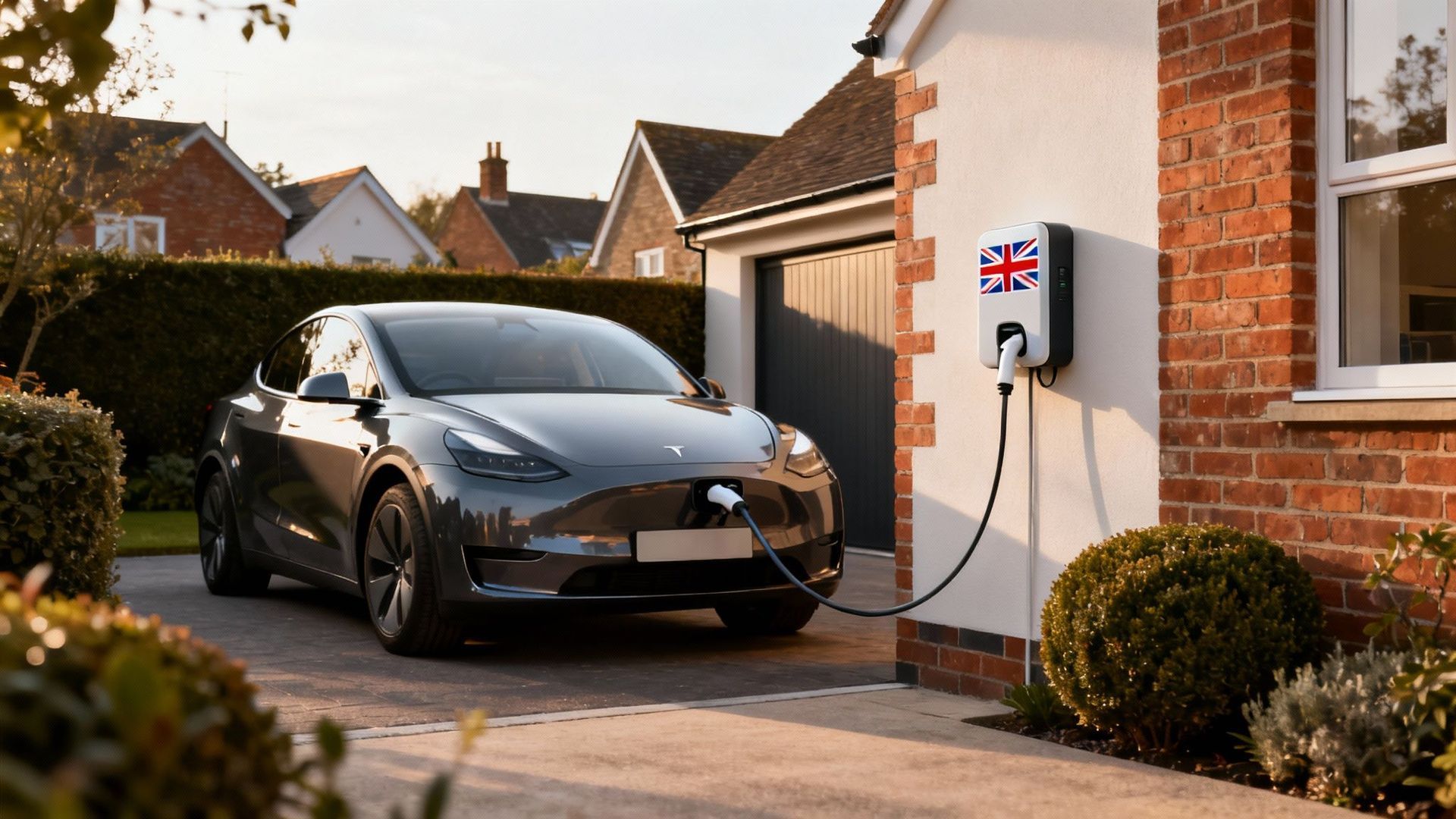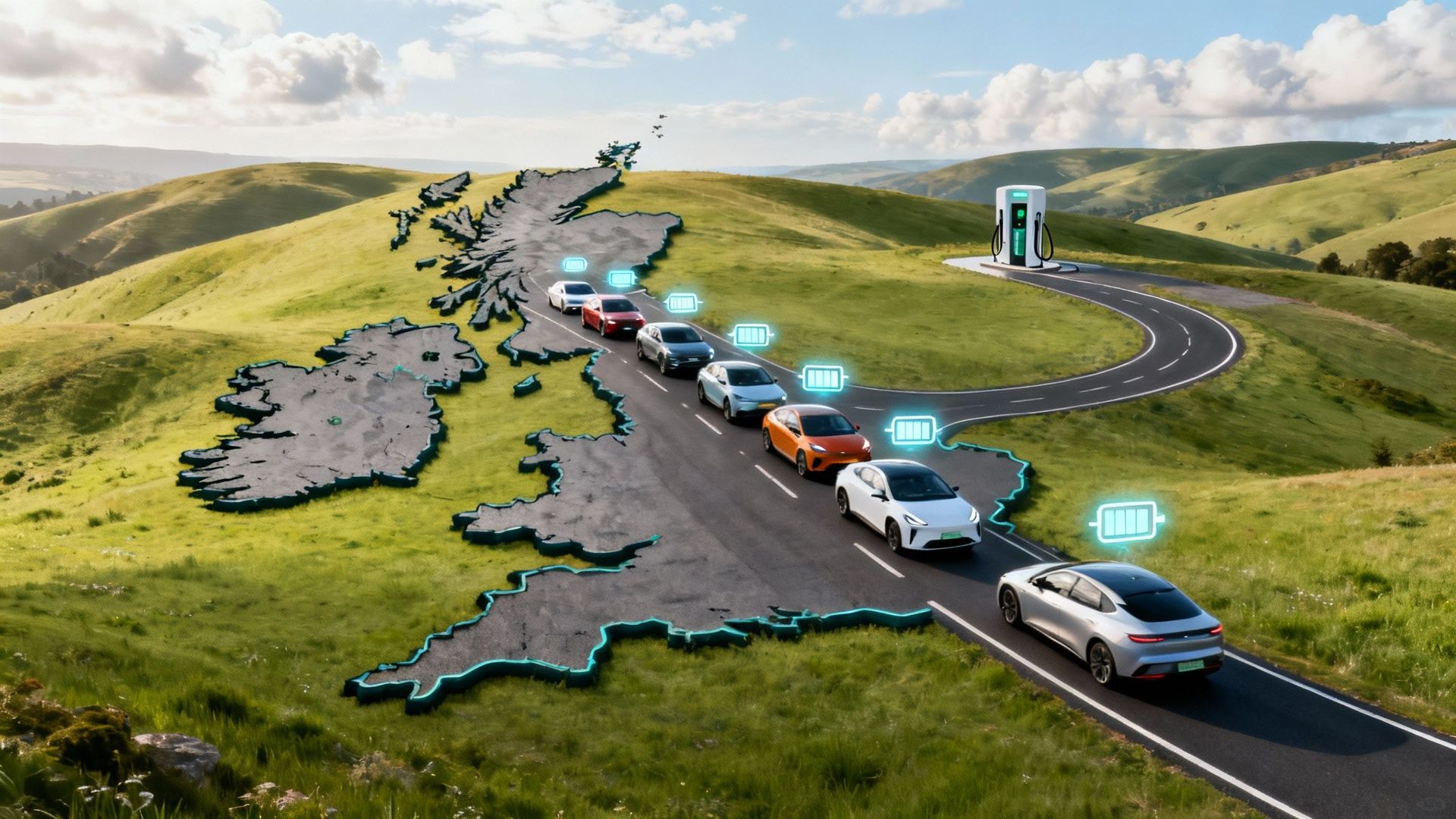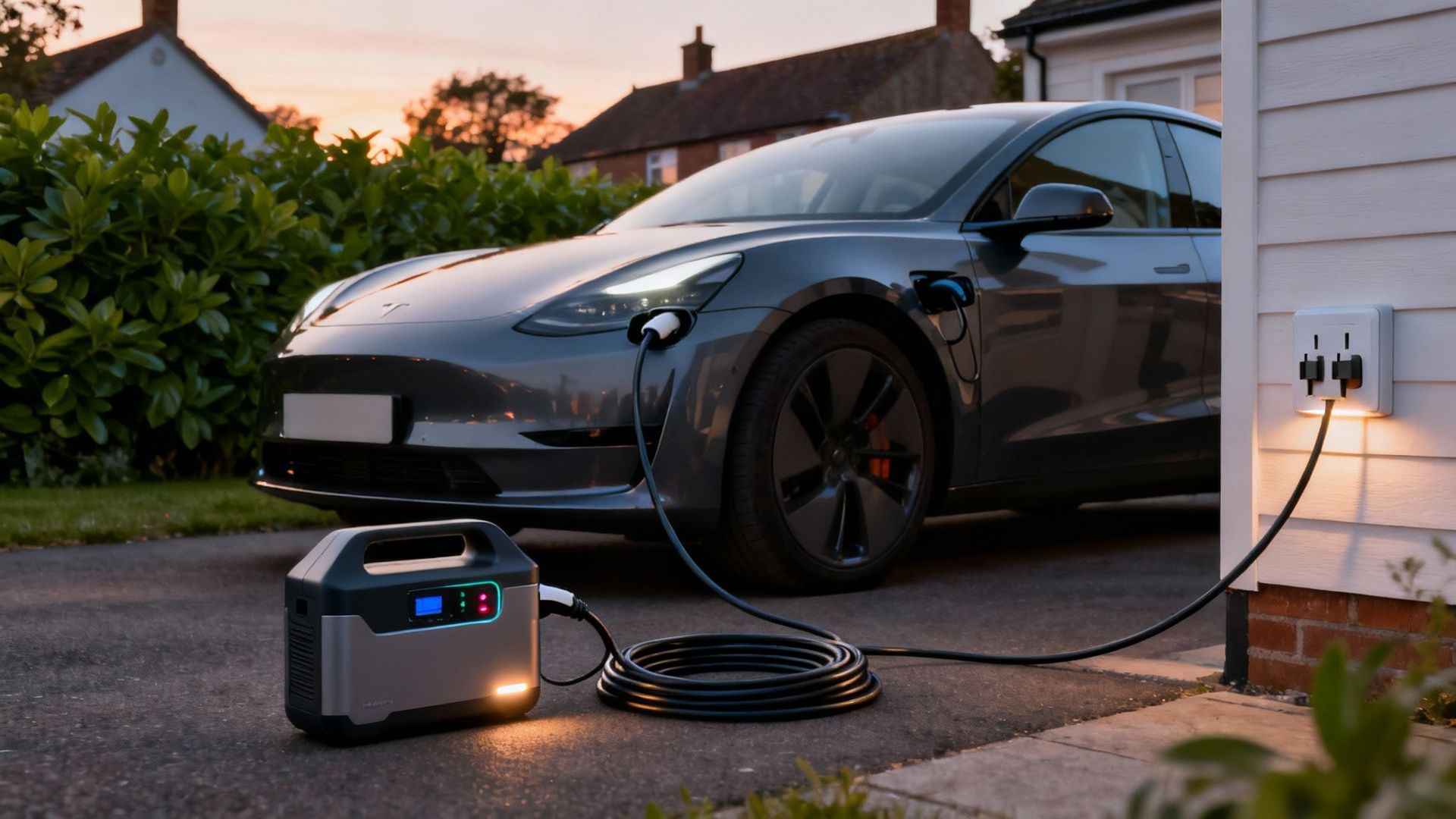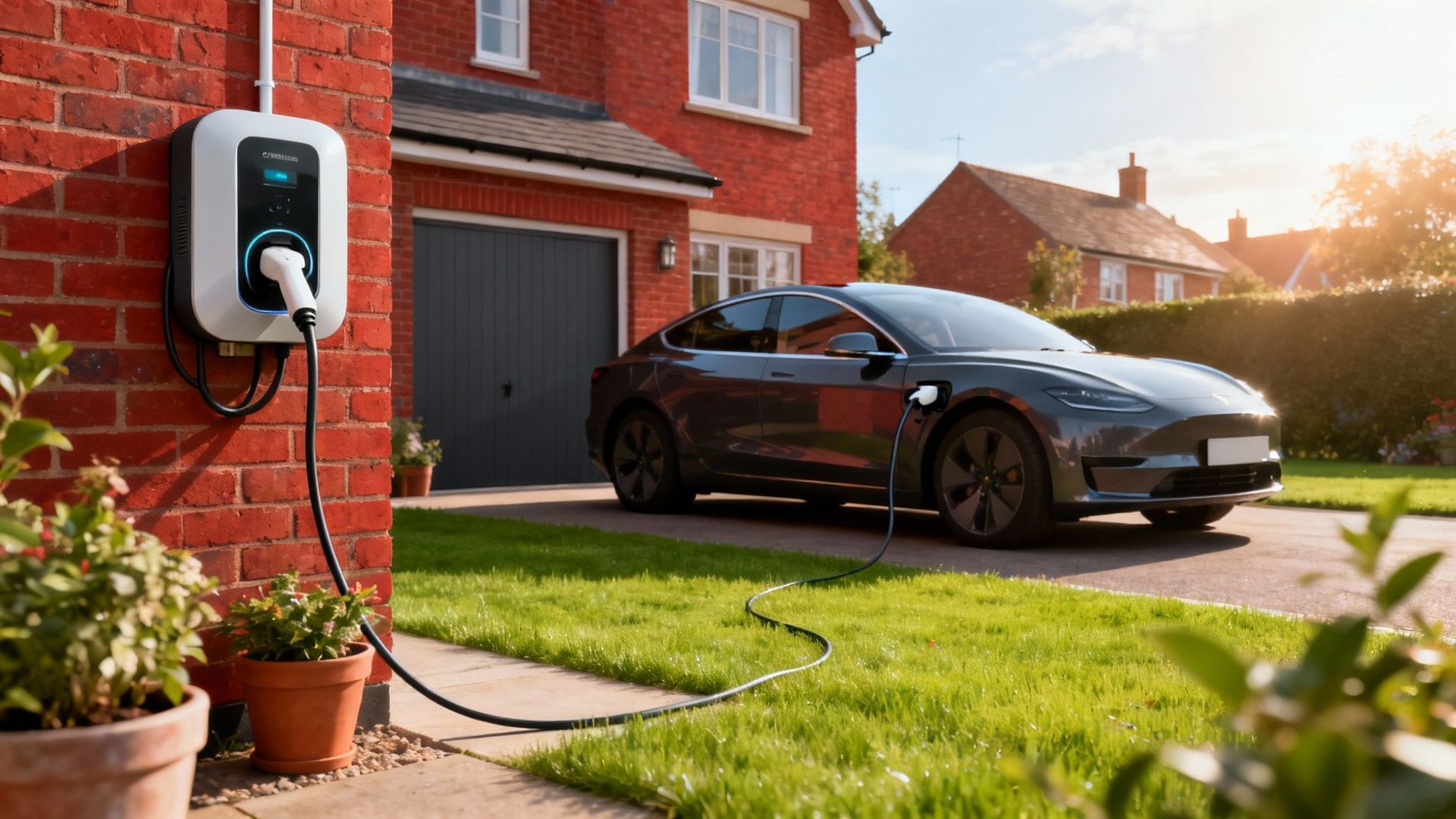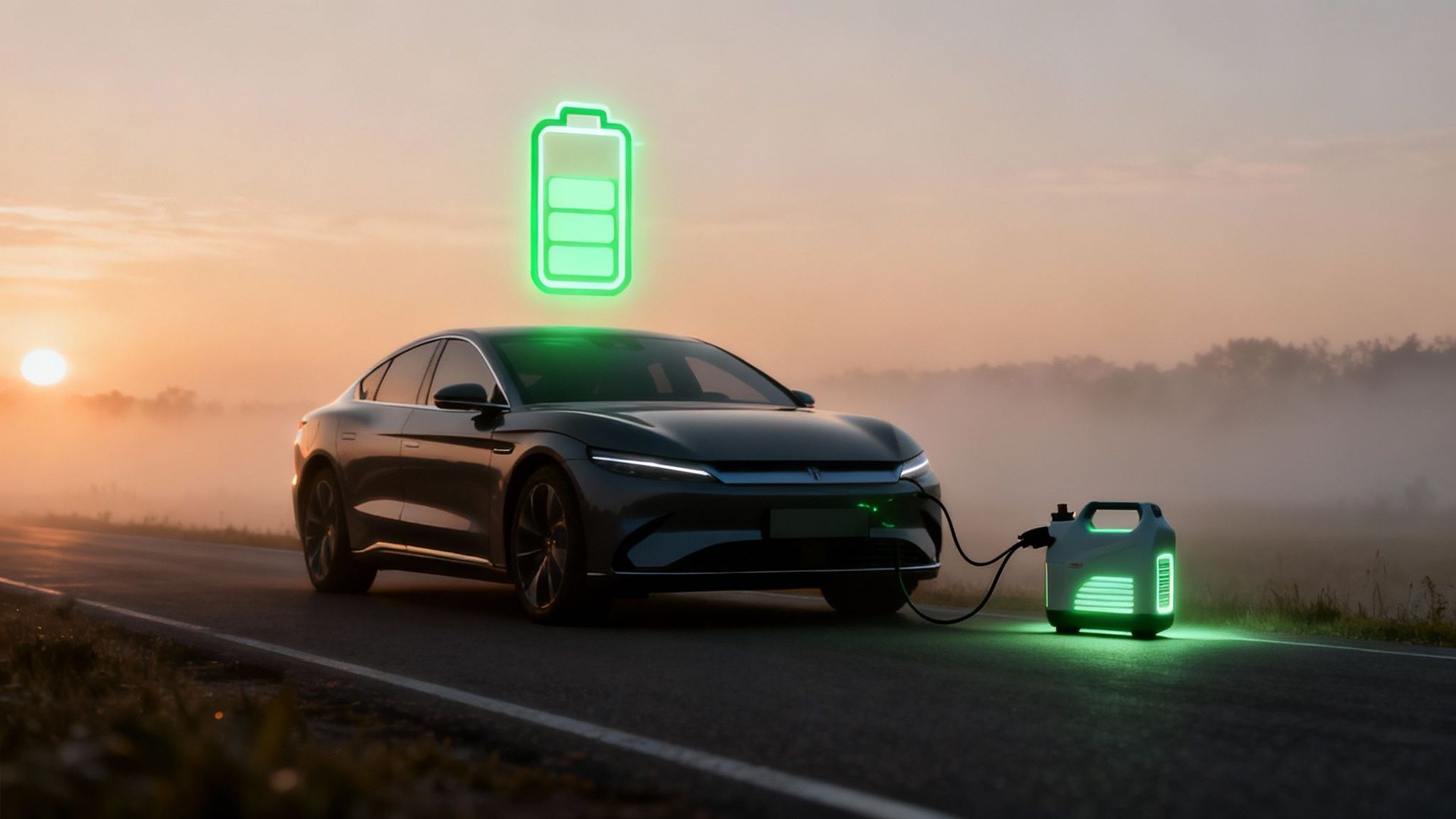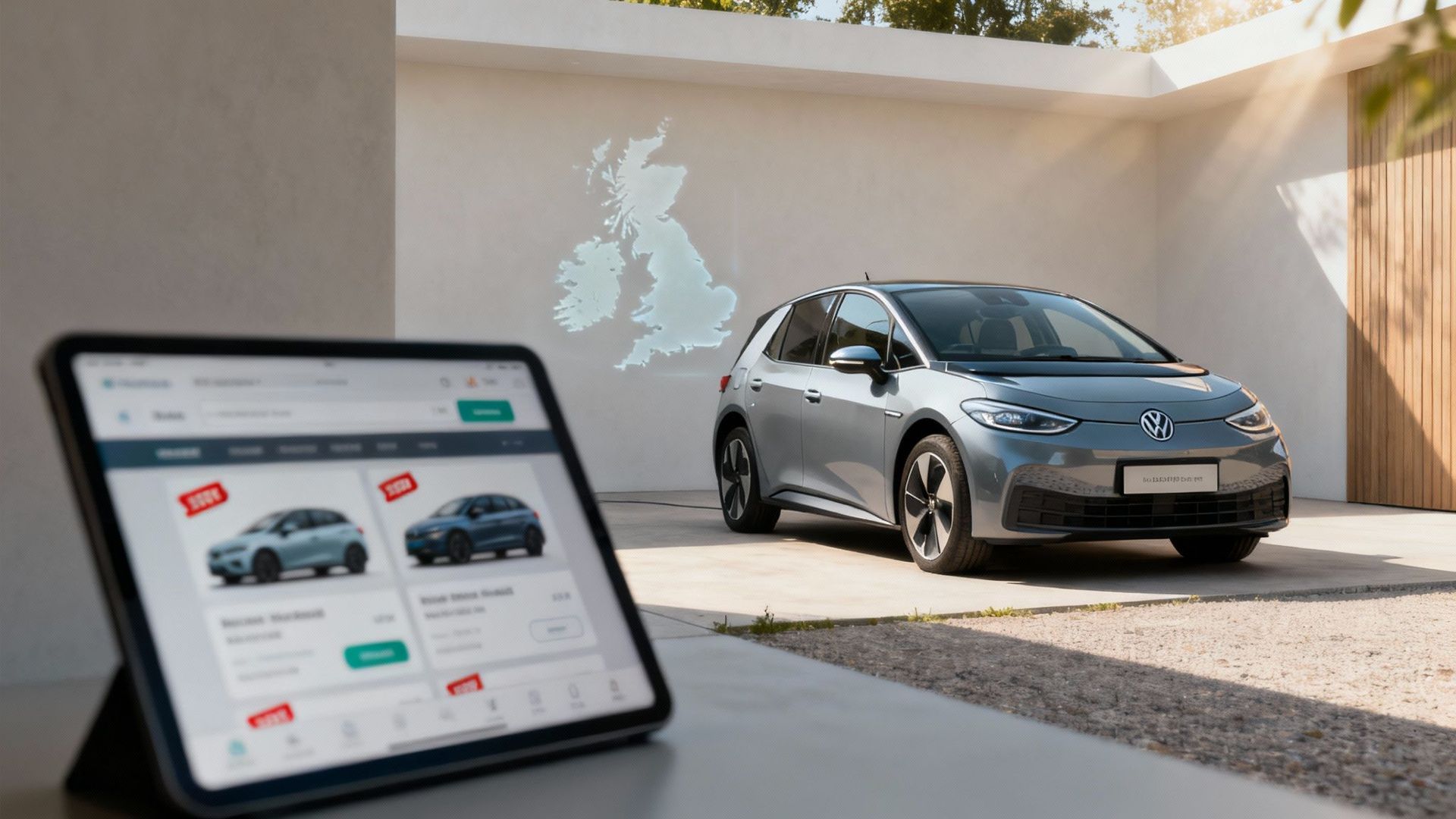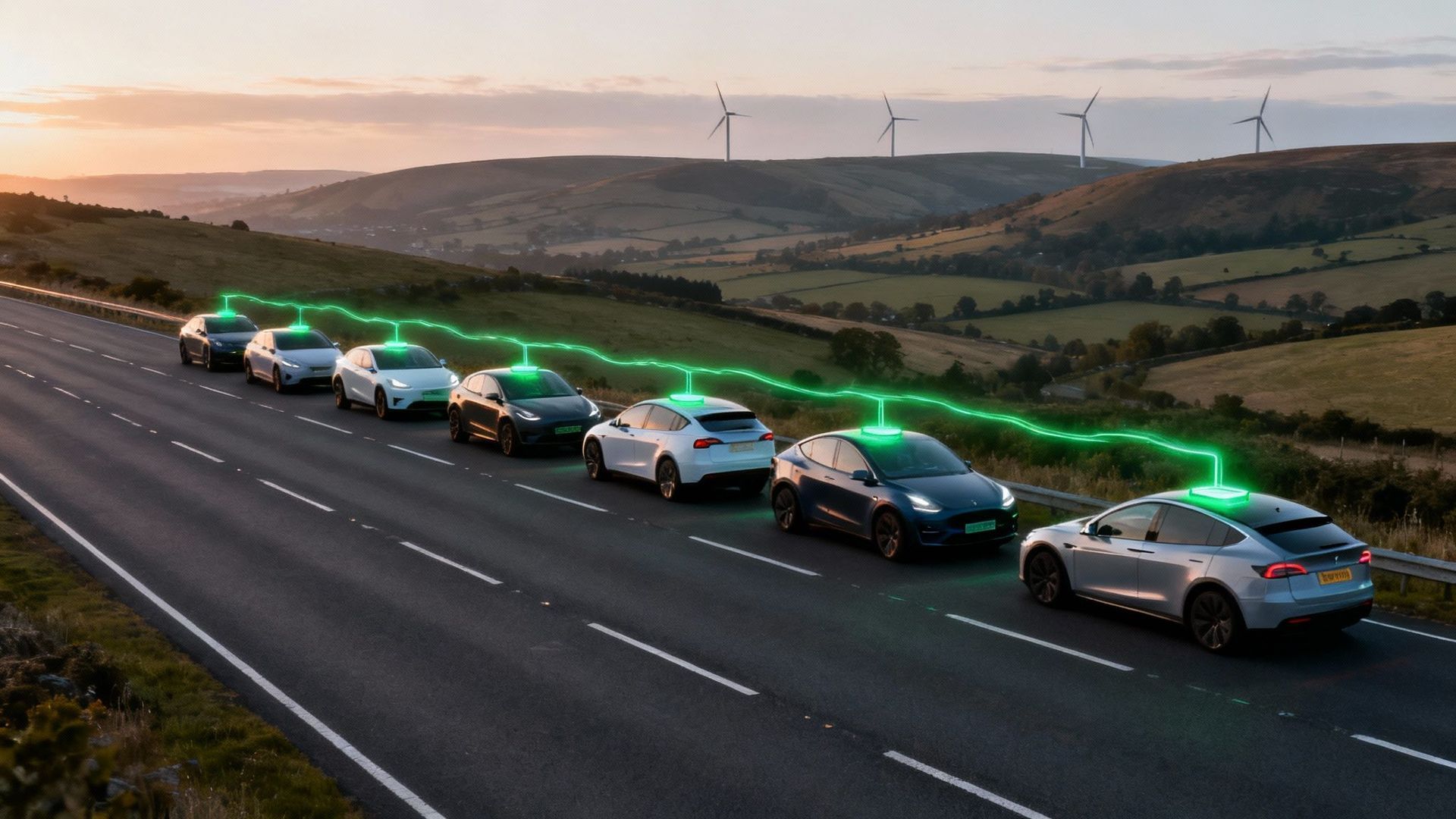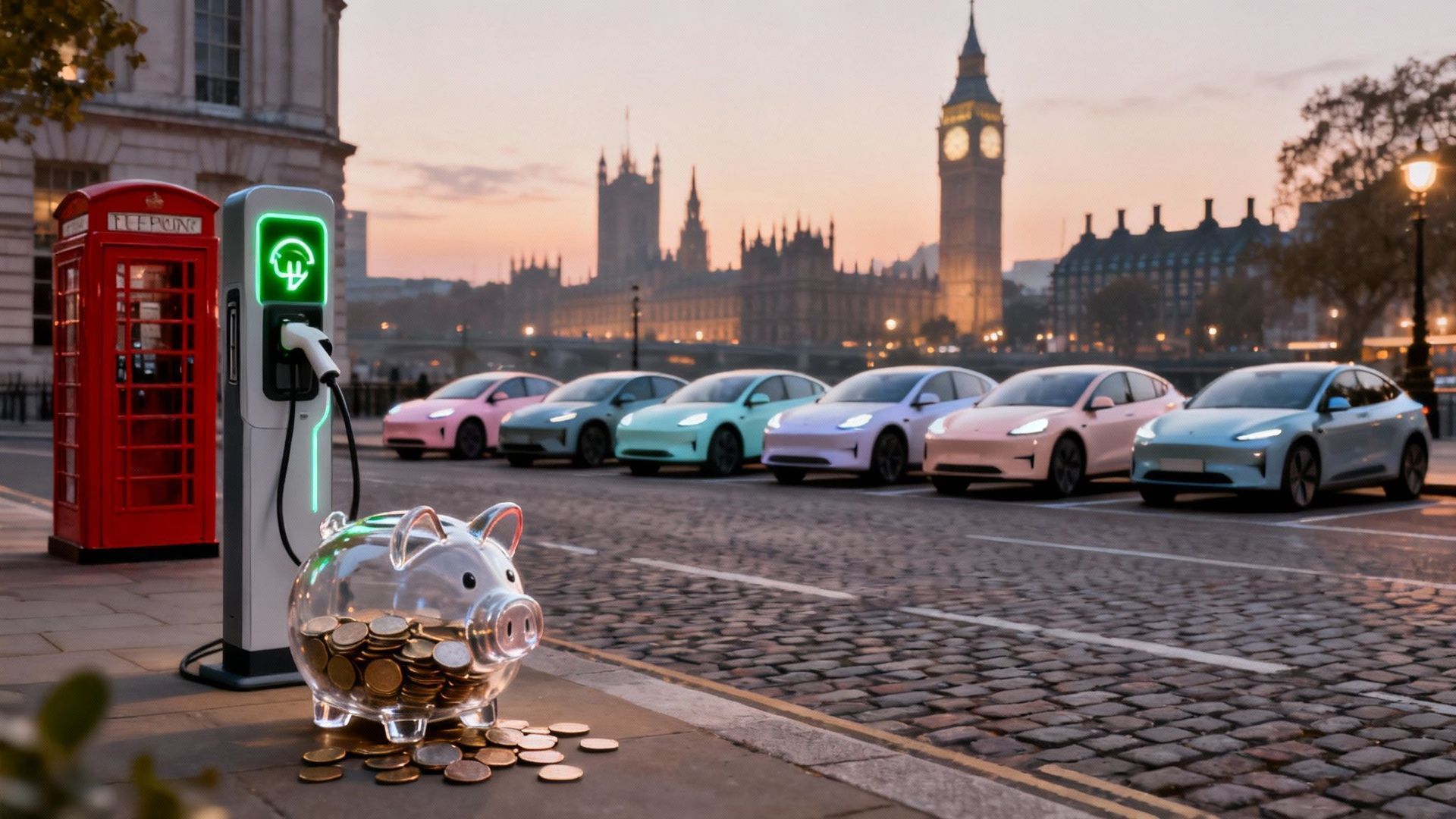Your Guide to Home EV Charger Installation: Don't Be a Muppet
Getting a home EV charger installed is your golden ticket to skipping the queues at public charge points and waking up to a full battery every single day. In essence, it means paying a qualified electrician to drill holes in your house so you don't have to. For any electric vehicle owner in the UK, this has quickly become a must-have upgrade, lest you be judged by your neighbours.
This isn't just about convenience. It's about making the whole EV ownership experience sane, affordable, and blissfully free from the drama of a forecourt full of broken chargers and crying children.
Why Your Driveway Is the New Petrol Station

Welcome to the future, where your driveway doubles as a filling station—minus the questionable sausage rolls and overpriced coffee. A few years ago, a dedicated home charger felt like a posh accessory for early adopters with more money than sense. Now, with electric cars becoming as common as traffic jams on the M25, a home EV charger installation has gone from a luxury to a non-negotiable part of the kit.
Let's cut through the marketing guff. A proper home charger is a purpose-built, weatherproof box. Its job is to safely deliver a steady stream of electricity to your car, far quicker and more reliably than a standard wall socket ever could without setting your house on fire.
The Problem with Three-Pin Plugs
You might be tempted to just use the "granny charger" that came with your car—that bulky cable that plugs into a regular three-pin socket. While it’s okay in a desperate, last-ditch emergency, relying on it full-time for your shiny new £50k electric car is a monumentally daft idea.
It's painfully slow, often taking well over 24 hours for a full charge on many models. More importantly, it puts a continuous, heavy strain on your home’s wiring that it simply wasn't designed to handle.
Think of it like trying to fill a swimming pool with a garden hose. You'll get there eventually, but it's wildly inefficient, frustrating, and you might cause a flood along the way. A dedicated home charger is the fire hose you actually need.
Escaping the Public Charging Chaos
The public charging network is growing, but so is the number of EVs on the road. That means more competition for chargers, more out-of-order units, and more time spent loitering in bleak retail park car parks, questioning your life choices.
While the infrastructure is improving, the reality is that relying solely on public chargers can be a gamble. A reliable setup at home removes that stress entirely. You just arrive home, plug in, and forget about it. If you're still weighing it up, our guide on whether you should invest in a home charger or stick with public networks offers a deeper dive into this first-world problem.
The UK's public network is expanding at a breakneck pace. In the first half of 2025 alone, the number of public charge points shot up by a staggering 27% , with 8,670 new points added. This boom brought the UK's total to over 82,000 public chargers and reflects the massive surge in EV adoption fuelling the demand for home installations.
Your Essential Pep Talk
Before you even start looking at hardware or installers, consider this guide your essential pep talk. We'll walk you through the entire home EV charger installation process, from checking your property's electrical setup to understanding what your car needs.
We’ll even touch upon the delightful world of UK electrical regulations you're about to become intimately familiar with. Think of this as your roadmap to achieving charging nirvana, right on your own driveway.
Understanding the Real Installation Costs (Brace Yourself)

Right, let’s get down to brass tacks. The glossy car brochure sold you a dream of pennies-per-mile motoring, but it conveniently skipped over the four-figure invoice that lands on your doormat after an electrician has been drilling holes in your house.
This is the financial reality check of a home EV charger installation .
Forget the marketing spin for a second. The price you pay isn't just for that fancy box on the wall. It’s for the expertise, the copper, the compliance certificates, and the sheer effort involved in safely wiring a high-power device into your home’s electrical nervous system.
The Baseline Bill: What Your Money Actually Buys
So, what sort of damage are we really talking about? Here in the UK, a standard home EV charger installation will typically set you back somewhere between £900 and £1,500 . This fee generally covers a 7kW smart charger —the sensible workhorse for most homes—and all the labour to get it fitted properly.
That baseline price assumes what electricians call a "straightforward" job. And as anyone who's ever hired a tradesperson knows, "straightforward" is a very flexible term. Usually, this price gets you:
- The 7kW smart charger unit itself.
- Up to 10 metres of cable, neatly clipped to a wall.
- Drilling through one standard brick or blockwork wall.
- Fitting the necessary protective devices (like an RCBO) at your consumer unit.
- The all-important electrical safety certificate to prove it’s been done right.
The Hidden Costs Waiting to Pounce
This is where the fun often begins. An initial quote is just the opening act; the expensive plot twists tend to emerge once the installer has had a proper look at your property's electrics.
The most common culprit for a budget blowout is your consumer unit (or fuse box, as many of us still call it). If it’s an old model from the dark ages, lacks the physical space for new circuits, or doesn't meet current safety regulations, it will need upgrading. That alone can add a hefty £200 to £500 to your bill before you’ve even unboxed the charger.
Think of your consumer unit as the gatekeeper for your home's electricity. If it's not up to the job of handling the extra demand from your EV charger, it simply won't let it in safely. And replacing the gatekeeper is never cheap.
Another classic is the cable run . That standard 10-metre allowance can disappear frighteningly quickly. If your consumer unit is at the front of the house but your driveway is at the back, or if you want the charger installed in a detached garage, the cost of extra armoured cable and the labour to run it will start to mount up.
A Realistic Look at Your EV Charger Installation Bill
To avoid any nasty shocks, it helps to see where your money might go. The initial quote is your starting point, but these common add-ons can make a real difference to the final figure.
| Item or Service | Typical Cost Range (£) | Painful Reality Check (Why you might pay more) |
|---|---|---|
| Standard Installation (7kW Charger + Labour) | £900 - £1,500 | Assumes your electrics are modern and the charger is close to your fuse box. |
| Consumer Unit (Fuse Box) Upgrade | £200 - £500 | Your existing unit might be too old, full, or non-compliant with current IET wiring regulations. |
| Additional Armoured Cable | £15 - £25 per metre | The "standard" 10m runs out fast. Long runs to a garage or awkward parking spot will add up. |
| Groundworks (Trenching for Buried Cables) | £30 - £60 per metre | If the cable needs to cross a garden, patio, or driveway, you're paying for digging and making good. |
| "Difficult" Cable Routes | £100 - £300+ | Running cables through lofts, under floorboards, or around complex obstacles takes time and skill. |
| Regional Price Variation | +10% to 15% | Installers in London and the South East often charge a premium due to higher operating costs. |
It's clear that the final bill is a delicate ecosystem of variables. Getting a few detailed quotes is the only way to know for sure what you'll be paying.
Ultimately, while the initial cost might seem steep, it's a one-off investment for years of cheap, convenient motoring. Understanding the potential financial pitfalls helps you budget properly and sidestep any surprises. And don't forget the big savings you'll make in the long run—you can see a breakdown of the financial incentives of using home charging to put it all into perspective.
Navigating UK Grants Without Losing the Will to Live

Ah, government grants. The promise of "free money," lovingly wrapped in enough red tape to gift-wrap a tank. For a while, the UK government was practically throwing cash at homeowners to get chargers installed. Those glory days are, for most of us, a distant memory.
The old OZEV (Office for Zero Emission Vehicles) grant that many early adopters enjoyed has gone the way of the dodo for most homeowners. Now, the focus has shifted, the rules are far more specific, and a lot of people are left scratching their heads.
This isn’t just a list of links; think of it as a strategic manual for making the bureaucracy work for you. Because while the government wants to help push the electric transition, they certainly don't make it easy.
Who Actually Gets the Money Now?
Let's be brutally honest: if you own a detached or semi-detached house with your own driveway, your chances of getting a grant for a home EV charger installation are pretty much zero. The government has decided you're capable of funding it yourself.
The current golden ticket is the Electric Vehicle Chargepoint Grant (EVCG) , and it's aimed squarely at a different crowd. You might be eligible if you:
- Live in a flat (whether you own or rent it).
- Rent any property (including houses).
The logic here is actually quite simple. People in flats often face shared parking nightmares and logistical headaches that single-family homeowners don't. Meanwhile, tenants can’t just start drilling holes in a property without the landlord's permission. The grant is designed to overcome these specific hurdles. So, if you live in a multi-storey block or rent from a landlord, listen up.
The EVCG offers a discount of up to 75% off the cost of buying and installing a charge point, capped at a maximum of £350 . It's not a life-changing sum, but it's a significant chunk off your final bill, turning a hefty expense into something far more palatable.
The OZEV-Approved Installer: Your Non-Negotiable Partner
Here’s the catch, and it’s a big one. You can't just get your mate Dave the electrician to fit a charger and then send the government an invoice. To access any grant funding, you must use an OZEV-approved installer.
This isn't just a bureaucratic hoop to jump through. These installers are specialists who have been vetted and trained to fit charge points safely and in line with all the correct regulations. They know the grant process inside-out and will typically handle the entire application for you, subtracting the grant amount directly from your final quote.
Trying to bypass this is a fool's errand. No approved installer, no grant money. End of story. This process also ensures the work is properly certified, which is crucial for your home insurance and general peace of mind. For context, new build properties are already ahead of the game, as our article on how all new UK homes must have EV charging installed explains.
Hacking the Paperwork Jungle
While your installer manages the application itself, you'll need to provide them with the right ammunition. Be prepared to gather proof of your eligibility. This will likely include:
- Proof of property: Tenancy agreements for renters or property deeds for flat owners.
- Proof of EV: Documents showing you own, lease, or have an eligible electric vehicle on order.
- Parking permission: Confirmation that you have a designated, off-street parking space dedicated to your property.
These schemes are no small gesture. By April 2025, the EVCG had already funded 20,654 home charging sockets with a total grant value of £15.1 million , showing a clear government push to support renters and flat-dwellers. You can find more insights in the official government statistics on gov.uk. The key is simply proving you're the person they're trying to help.
Choosing a Charger Without an Existential Crisis
Welcome to the paradox of choice, EV edition. You’ve sorted the finances, navigated the grants, and now you’re staring at a wall of plastic boxes that all promise to be the best thing since sliced bread. Tethered or untethered? 7kW or 22kW ? Smart or… well, they’re all smart now, so that’s one less thing to worry about.
Don't panic. Choosing the right hardware for your home EV charger installation doesn't mean you need a degree in electrical engineering or a week-long meditation retreat. You just need to focus on the handful of differences that will actually matter in your day-to-day life.
The Great Cable Debate: Tethered vs. Untethered
This is the first, and honestly, the biggest decision you'll make. It all boils down to a simple trade-off: pure convenience versus a tidier look.
A tethered charger has the charging cable permanently attached. You just pull up, grab the cable, and plug it in. It’s the peak of efficiency, especially on a miserable, rainy Tuesday morning when you’re already running late.
On the other hand, an untethered charger is just a socket on the wall. You’ll need to get the cable that came with your car out of the boot, plug one end into the unit and the other into your car. It definitely looks much neater on the wall but adds about thirty seconds of faff to your routine.
My advice? If you value speed and convenience above all else, get a tethered unit. If you can’t stand the sight of a coiled black cable hanging on your pristine wall, go untethered. It really is that simple.
To help you decide, here’s a brutally honest comparison table.
Tethered vs Untethered: The Eternal Struggle
A satirical but practical comparison to help you decide which charger type won't drive you mad.
| Feature | Tethered Charger (The Lazy Option) | Untethered Charger (The Tidy Option) |
|---|---|---|
| Convenience | Unbeatable. Just grab and go. Perfect for the perpetually rushed. | A bit of a faff. Involves getting your own cable out of the boot every time. |
| Aesthetics | Can look a bit messy, with a thick black cable permanently on display. | Clean and minimalist. It's just a tidy little box on the wall. |
| Cable Wear | The attached cable is used constantly, so it will eventually wear out. | You can replace your own cable whenever you like. |
| Compatibility | Usually comes with a Type 2 connector, which is the UK standard. No issues here. | Lets you use any cable, which is useful if a visitor has a different connector (highly unlikely in the UK). |
Ultimately, there's no wrong answer here, just the one that best suits your temperament.
The Power Obsession: 7kW vs 22kW
Now we come to the power question. You'll see chargers advertised with all sorts of kilowatt (kW) ratings, but for 99% of UK homes , this is an incredibly simple choice.
A 7kW charger is the undisputed champion for home charging. It's fast enough to give you about 25-30 miles of range per hour , which means even a completely flat EV battery will be full by the next morning. Critically, it runs on a standard single-phase electricity supply—the kind that powers virtually every house in the UK.
Then you have the 22kW chargers . They're the stuff of dreams for speed freaks, capable of adding up to 70 miles of range per hour . The catch? A massive one. They require a three-phase electricity supply, something you’ll rarely find outside of commercial properties or enormous, custom-built houses. Getting your home upgraded to a three-phase supply is an eye-wateringly expensive and disruptive job.
So, unless you know for a fact that you have a three-phase supply (and if you have to ask, you don't), just get a 7kW charger . It's more than enough for overnight charging.
What 'Smart Charging' Actually Means
You might have noticed that all new home chargers sold in the UK since mid-2022 have to be ‘smart’. This isn’t just marketing fluff; it’s a legal requirement with some very real benefits for you.
At its core, smart charging means the charger is connected to the internet. This unlocks two crucial features:
- Scheduled Charging: You can use an app to tell your charger to only top up during off-peak hours (usually overnight) when electricity is dramatically cheaper. This is the single biggest trick to making EV ownership affordable.
- Grid Protection: Your charger can communicate with the National Grid. During moments of extreme national demand, it can pause your charge for a few minutes to help prevent blackouts. You won’t even notice it’s happening.
In short, smart charging saves you a packet on your electricity bills and helps keep the lights on for everyone else. It's a mandatory feature that’s genuinely useful.
The Actual Installation Process Explained
The big day is here. After weeks of research, quoting, and soul-searching, a qualified electrician is now standing on your driveway, holding a very large drill. What could possibly go wrong?
This is your pragmatic, no-nonsense walkthrough of the home EV charger installation from a homeowner's point of view. Spoiler alert: your primary role involves making tea and staying well out of the way.
The All-Important Pre-Installation Survey
Before anyone starts drilling into your walls, the installer should have already completed a pre-installation survey. Often, this is done remotely using photos and a questionnaire, but for more complex jobs, they might pop round in person. It's tempting to rush this bit, but pay attention .
This survey is where the installer figures out if your home’s electrics are from this century, where your consumer unit lives, and the best route for the cable. Being honest about that dodgy wiring in the garage is crucial. It helps prevent that dreaded mid-install price hike when they discover your house is one dodgy kettle away from a total blackout.
Think of the survey as the electrician's battle plan. A good plan means a quick, clean operation. A rushed one results in chaos, unexpected costs, and a lot of muttering about "cowboys" from the professional you've hired.
What the Installer Will Actually Be Doing
Once the pleasantries are over, the real work begins. The process is usually a blur of activity, but it generally breaks down into a few key phases of drilling, pulling cables, and looking thoughtfully at your fuse box.
Here’s a rough play-by-play of what you can expect to see:
- Power Down: First thing's first: they need to make everything safe. That means turning off your electricity at the mains. Enjoy the brief, blissful silence before you remember the Wi-Fi is down.
- Consumer Unit Work: Your electrician will install a new, dedicated circuit just for the charger. This usually involves fitting a new Miniature Circuit Breaker (MCB) or, more likely these days, an RCBO (Residual Current Circuit Breaker with Overload protection) into your consumer unit.
- The Cable Run: This is often the most disruptive part of the job. A thick, armoured cable will be run from the consumer unit to your chosen charger location. Depending on the route decided during the survey, this might be neatly clipped along an external wall, run through a loft, or threaded under floorboards.
- Drilling The Hole: A hefty core drill creates a surprisingly neat hole through your external wall. This is where the cable makes its grand entrance into the outside world.
- Mounting the Charger: The charging unit itself is securely mounted to the wall. This is the moment it starts to feel real. They’ll connect the armoured cable and make sure everything is properly weatherproofed and sealed against the elements.
The Final Checks and Grand Handover
With all the hardware in place, the final stage is about making sure everything works safely and that you actually know how to use it. Don't underestimate this part; it's just as important as the physical installation.
Here are the final, critical checks your installer will be running.

These final checks are non-negotiable. They confirm the system is not only working but also completely safe and compliant with all UK electrical regulations.
The process wraps up with the commissioning of the charger. The power is switched back on, and the installer runs a series of tests to check voltages, connectivity, and safety features. They'll then connect it to your Wi-Fi and should give you a demo of the companion app, showing you how to schedule charges to take advantage of those sweet, sweet off-peak electricity rates.
Crucially, before they pack up their tools, they must provide you with an Electrical Installation Certificate (EIC) or a Minor Electrical Installation Works Certificate (MEIWC). This is the official document proving the work was done to the required safety standards. Do not let them leave without it . This certificate is vital for your home insurance and any future property sale. It’s your proof that the job was done by a professional, not a chancer.
Your Burning Questions Answered
Alright, let's tackle those questions you've been pondering but maybe felt a bit awkward asking. We've all been there. When it comes to something as new as installing an EV charger at home , there are no silly questions. Here’s the straightforward truth.
Can I Just Install It Myself to Save a Few Quid?
Let me be blunt: absolutely not. Unless, of course, you enjoy the thrill of voiding your home insurance and risking a serious electrical fire. Seriously, don't even think about it.
In the UK, fitting an EV charger is what's known as 'notifiable work' under Part P of the Building Regulations. This is a critical point. It means the job must be done by a qualified electrician who can sign off on their own work and register it with your local authority. Once complete, they'll give you an Electrical Installation Certificate (EIC). This isn't just a piece of paper; it's your proof that the installation is safe, legal, and compliant.
A DIY installation is a recipe for disaster. The few hundred quid you might save are nothing compared to the risk of fire, electrocution, or having to explain to an insurance assessor why a YouTube tutorial seemed like a good substitute for years of professional training.
Will My Electricity Bill Skyrocket?
It’s going to go up, there’s no escaping that. But 'skyrocket' is probably pushing it. This is precisely where a modern smart charger earns its keep. In fact, since mid-2022, all new chargers sold in the UK are legally required to have smart functionality, which is your best friend for keeping costs down.
These smart features let you schedule charging sessions to take place in the dead of night. If you switch to an EV-friendly energy tariff, you can charge when electricity is at its absolute cheapest, often between midnight and 5 am. The cost per mile can be staggeringly low compared to petrol or diesel. So, while your bill will rise, it should be a fraction of what you were shelling out for fuel. If it's genuinely rocketing, you're charging at the wrong time of day.
How Long Does a Typical Installation Take?
For a standard, no-fuss installation, an experienced electrician should be done and dusted in about two to four hours . What's a "no-fuss" job? Think of a house with a modern, compliant consumer unit that has space for a new circuit, and the charger is being mounted on a simple external wall close by.
Things get more complicated if you live in an older property, your consumer unit needs replacing, or you want the charger installed in a detached garage at the bottom of the garden. In those cases, the job could easily take a full day. The pre-installation survey is invaluable here; it will give you a much more realistic timeframe and prevent any surprises on the day.
Do I Need Planning Permission?
Good news on this front. For most homeowners in England, putting up a wall-mounted charger falls under 'permitted development,' which means you don't need to go through the hassle of applying for planning permission.
There are a few key exceptions, though. If you live in a listed building or a designated conservation area, you'll need to check with your local council first. The rules also state that the unit can't be excessively large or be installed facing a public highway. If you've got an unusual plan in mind—like installing a freestanding charger in your front garden—it's always best to have a quick word with your local planning authority beforehand. It could save you from a very official letter and an order to remove it later on.
At VoltsMonster , we're all about cutting through the noise and giving you the straight-talking advice you need. From car reviews to charging guides, we've got you covered. Explore more at https://www.voltsmonster.com.

